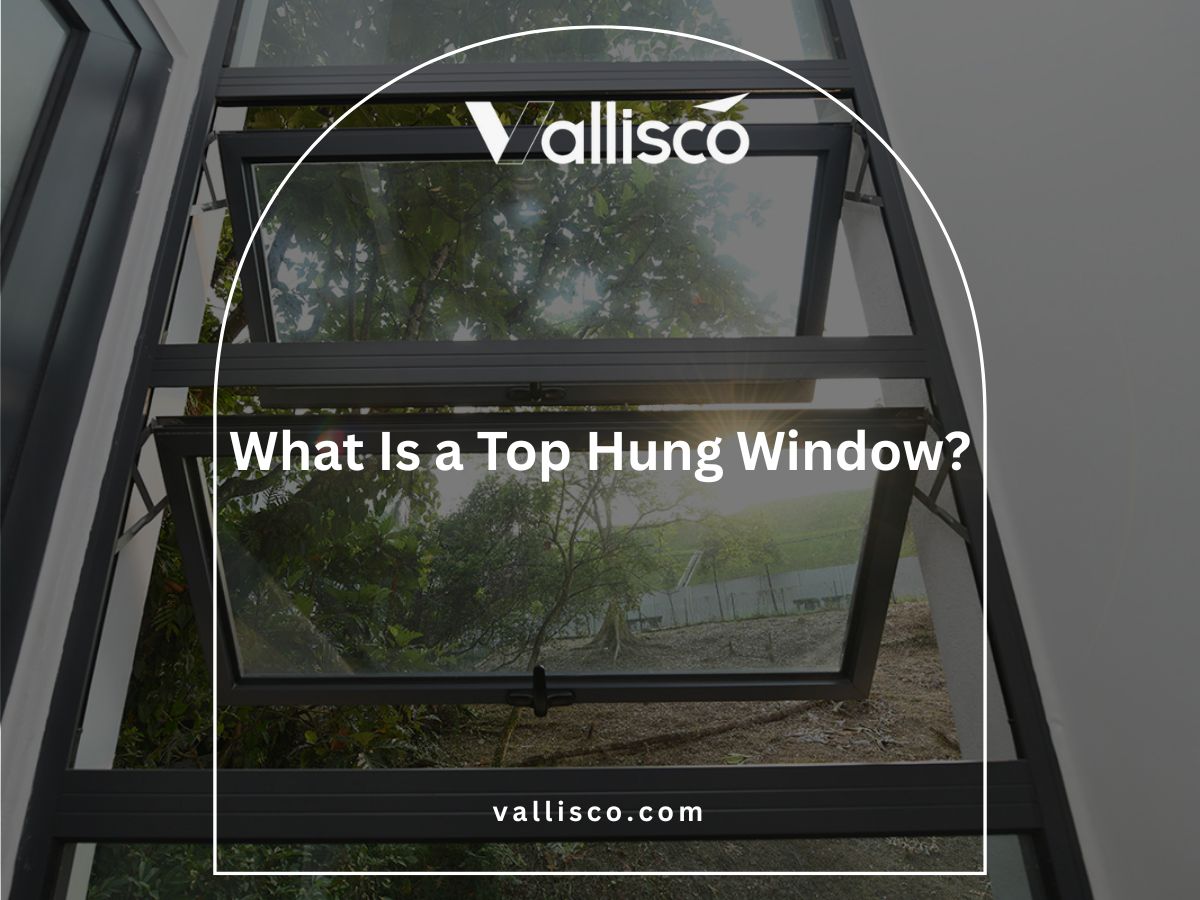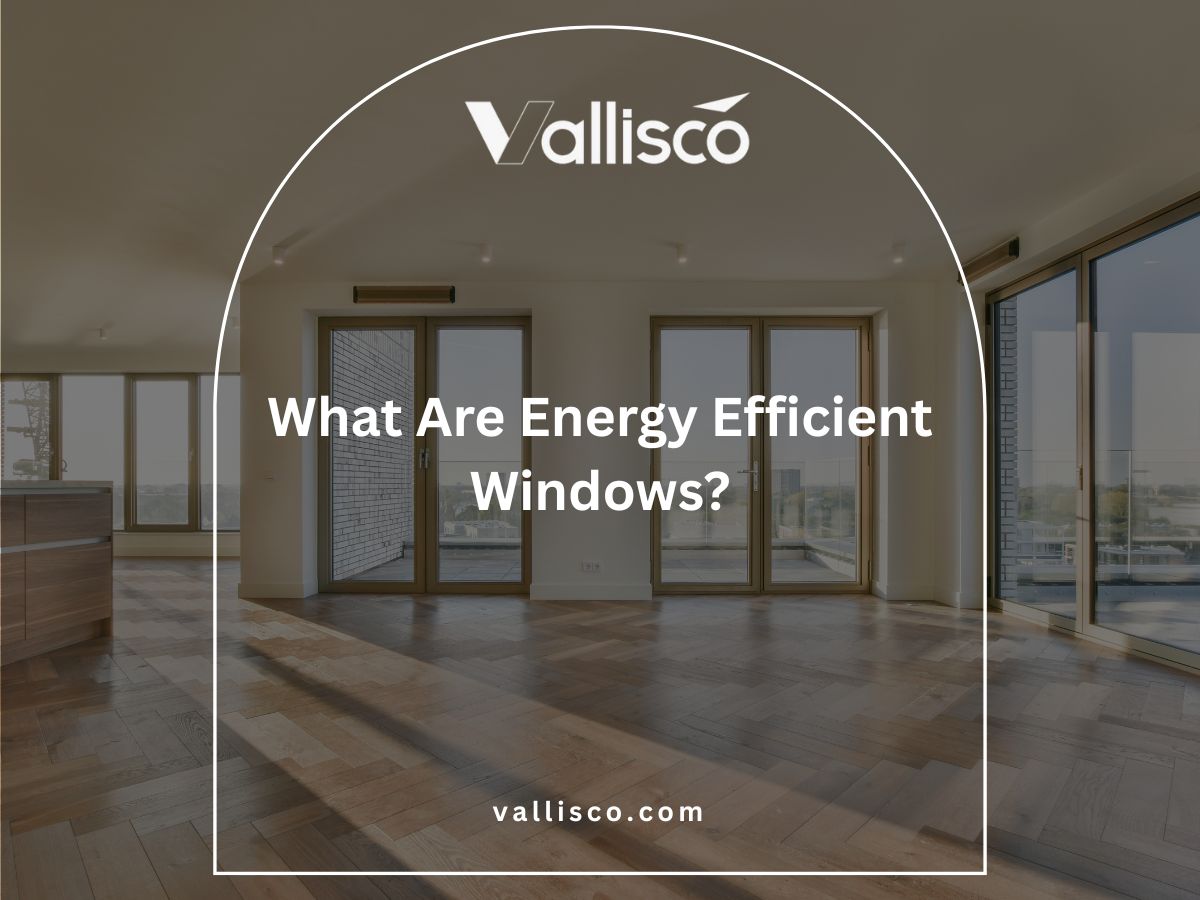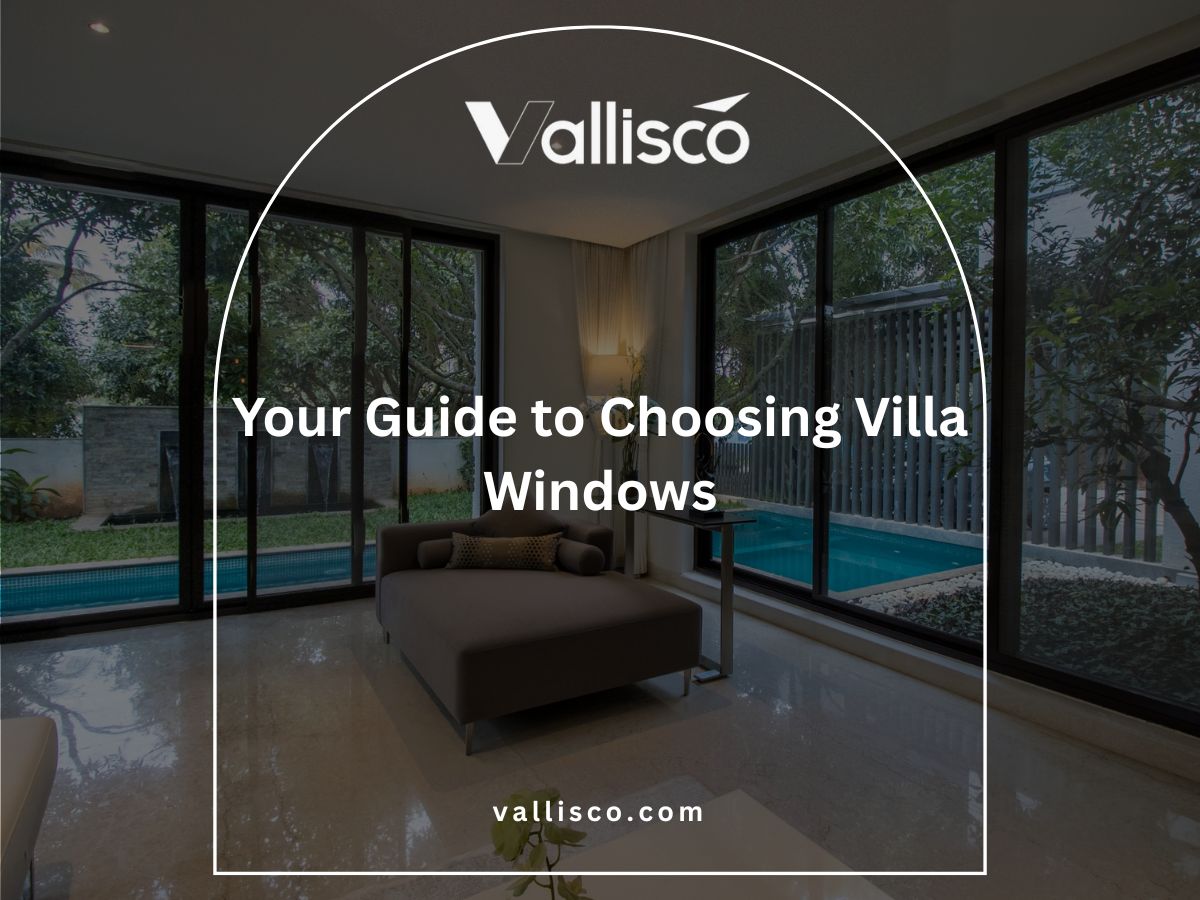One general contractor we worked with admitted that his client didn’t really know what a skylight was. He assumed it was just a window on the roof.
It wasn’t until we explained the types and benefits that the real value clicked.
That confusion isn’t unusual, and it’s fixable.
As a manufacturer of commercial skylight systems, we’ve had these conversations thousands of times. We understand how important clarity is when you’re making investment-level decisions for your building or your client’s.
This article breaks down skylight windows in simple terms:what they are, how they function, when to use them, and why they can be a smart business choice.
You’ll find clear answers to the questions your clients are already asking.
So, let’s get started!
1. What Is a Skylight Window?
A skylight window is a roof-mounted window designed to bring natural light into a building from above. Unlike traditional windows that rely on wall space, skylights use unused ceiling space to brighten up interior areas, especially those far from exterior walls.
Here’s what defines a skylight window:
- Skylights are installed on sloped or flat roofs, creating a direct channel for daylight.
- Some are purely for light; others can open to provide ventilation.
- Sizes, shapes, glazing, and frame materials can all be tailored to your building’s needs.
When you’re designing with longevity and functionality in mind, skylights can be one of the most effective and underused tools on the table.
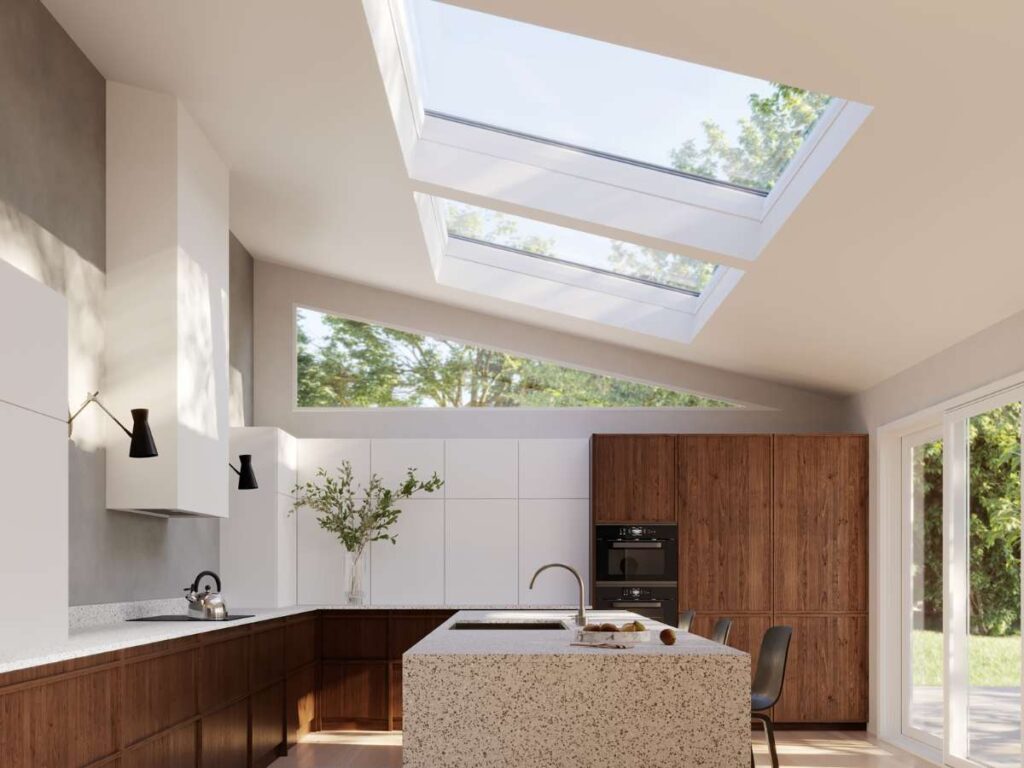
2. Benefits of Installing a Skylight Window
Skylights do more than just look good. They change how a space feels and functions. We’ve worked with businesses who didn’t realize how big the impact would be until after installation. These are the 4 benefits we see most often in commercial settings.
Brings in Natural Light
Some rooms just don’t get enough daylight, no matter how many windows you install. We’ve helped clients brighten up dark corners of large warehouses, long office hallways, and even restrooms without adding new walls or fixtures.
Skylights channel sunlight directly from above, reaching areas that side windows can’t. That extra daylight makes a big difference in how the space feels to employees and visitors alike. In many cases, it can completely transform how people use the space.
Reduces Energy Use and Costs
One client told us their energy bill dropped by double digits after installing skylights in their production floor. It makes sense: more natural light during the day means fewer overhead lights running.
Depending on your building’s layout and skylight placement, you can cut down on both lighting and HVAC costs, especially when paired with smart glazing and automated shades. Over time, these savings often offset the installation cost.
Enhances Mood and Productivity
Lighting affects people more than most realize. We’ve seen workplaces where simply adding skylights improved focus and reduced complaints about eye strain or fatigue. When a space feels open, bright, and welcoming, people respond better. Employees tend to be more alert, and customers spend more time in the space. It helps create an environment where people actually want to be.
Adds Long-Term Property Value
Skylights aren’t just functional. They’re an architectural upgrade that adds real value to your building. One real estate developer we worked with said the skylights were what closed the deal with a premium tenant.
When done right, Vallisco’s skylights can increase your property’s appeal, especially for high-end office tenants or retail brands looking for something that stands out. It becomes a feature you can market, not just a utility.
3. Common Types of Skylight Windows
Skylight windows come in a variety of designs, each offering different benefits based on placement, ventilation needs, and aesthetic preferences. Understanding the differences can help you choose the best type for your space—whether you’re aiming to brighten a room or improve airflow.
| Type | Design Description | Ventilation | Best For | Installation Angle | Key Benefit |
| Fixed Skylight | Non-opening glass panel installed on the roof. | No | Rooms that only need natural light | Pitched roofs | Simple design, leak-resistant |
| Ventilated Skylight | Operable skylight that opens manually or automatically. | Yes | Kitchens, bathrooms, humid areas | Pitched or flat roofs | Provides both light and airflow |
| Tubular Skylight | Small dome on the roof connected to a reflective tube. | No | Hallways, closets, small dark spaces | Any (especially flat roofs) | Compact, great for tight spaces |
| Dome Skylight | Curved acrylic or polycarbonate dome structure. | Sometimes (with vents) | Commercial spaces, garages | Typically flat roofs | Durable, impact-resistant, sheds water well |
| Pyramid Skylight | Four sloped panels forming a pyramid shape. | Sometimes | Large open spaces, atriums | Flat or low-slope roofs | Stylish, eye-catching architecture |
| Ridge Skylight | Runs along the roof ridge with two or more glass panels. | Yes (often) | Long spaces, hallways, offices | Roof ridges (gable roofs) | Maximizes light over a wide area |
4. Materials Used in Skylight Construction
When people ask what skylights are made of, I always say this, materials matter more than you think. They affect how much light comes in, how durable the skylight is, and even how much you’ll spend on maintenance.
Here’s a full list of the most commonly used materials in skylight construction:
- Tempered Glass: This is one of the strongest options and a favorite in commercial spaces. It’s heat-treated for durability and designed to break into small, safe chunks if damaged.
- Laminated Glass: Made of two glass layers with a plastic film in between, this material stays intact even when cracked. I’ve seen it used in schools and hospitals where safety and sound control are top priorities.
- Acrylic (Plexiglass): Lightweight and affordable, acrylic works well in large skylights where weight is a concern. It’s less clear than glass but more resistant to impact.
- Polycarbonate: This is the toughest glazing option out there. I’ve recommended it for factories and buildings in storm-prone areas, it handles just about anything.
- Fiberglass: Not as common today, but still used in some industrial applications. It’s strong and diffuses light evenly, though it can yellow over time.
- Aluminum Frames: These are the most widely used frames in commercial skylights. They’re light, won’t rust, and hold up well in all kinds of weather.
- Vinyl Frames: You won’t see vinyl much in commercial projects, but it does show up in small-scale jobs. It’s low maintenance but not as durable in tough climates.
- Wood Frames: Mostly used for decorative or specialty skylights. Wood adds warmth and character but requires more upkeep than metal or vinyl.
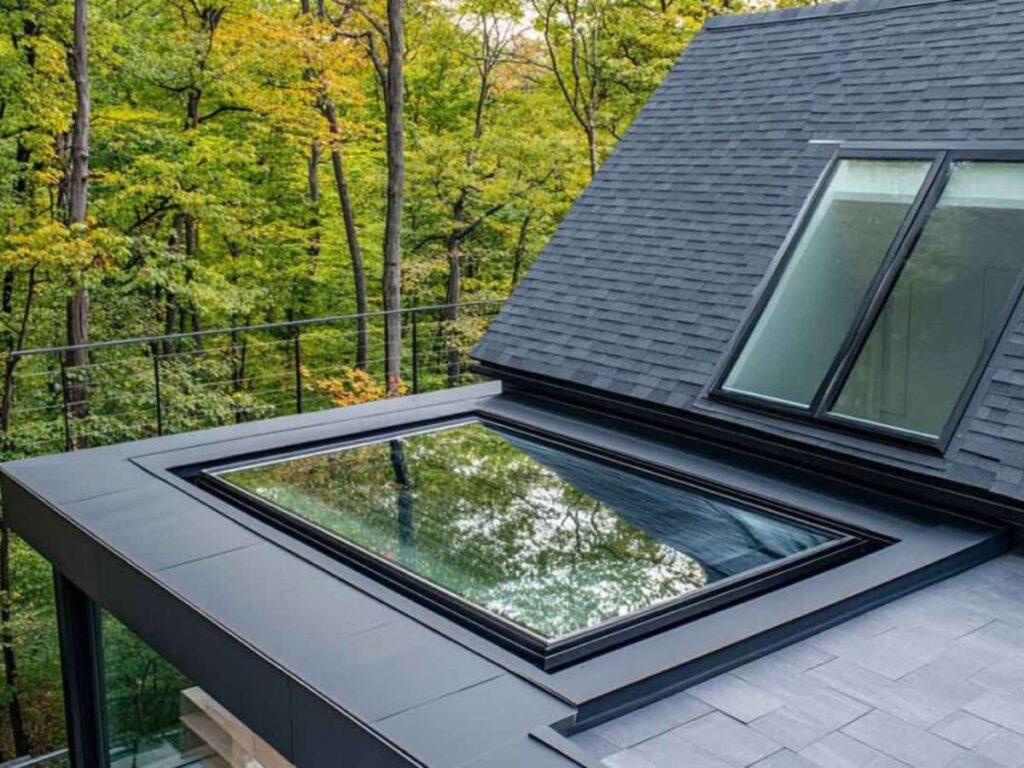
5. Where Can You Install Skylight Windows?
I’ve had clients assume skylights are only for fancy homes or custom offices. Not true at all. In fact, they’re one of the most versatile upgrades for all kinds of commercial buildings. Here are three of the most common places I see them used, and why they work so well.
Commercial Offices and Workspaces
Natural light has a huge impact on how people feel during the workday. I’ve seen plain office spaces completely transformed just by adding a few fixed skylights in key spots. Skylights are often installed above open-plan desks, hallways, or shared spaces like lounges and break areas. The extra daylight helps reduce reliance on artificial lighting and boosts productivity.
Warehouses and Industrial Buildings
This is one of the most underrated places to install skylights. Warehouses are usually large, open, and poorly lit unless you flood them with overhead lights. I’ve worked on projects where skylights dramatically cut down on energy use while also making the space feel less closed-in. Ventilated models are especially useful for reducing heat buildup in high-roof environments.
Retail and Customer-Facing Spaces
In stores, cafes, or showrooms, lighting affects everything, from how products look to how long customers stay. A skylight can help set the mood without a single bulb. I’ve seen skylights used to highlight displays, brighten up entryways, or create a more welcoming environment without messing with the floor layout. It’s a small structural move with big visual impact.

6. Key Considerations Before Installation
Installing a skylight isn’t as simple as cutting a hole in the roof and dropping in a window. I’ve seen projects go sideways because someone skipped over the planning stage. A little foresight here can save you serious time, money, and frustration later.
Before locking in your design, here are the key things to think about:
- Roof Type and Slope: Not every skylight works with every roof. I’ve worked on flat-roof projects that needed special mounts and flashings just to make things watertight.
- Purpose of the Skylight: Are you looking for just light? Or do you want ventilation too? I’ve had clients regret not choosing an operable skylight after realizing how stuffy their space felt later on.
- Building Orientation: Skylights facing east or west can bring in harsh sunlight at certain times of day. It’s worth thinking through sun angles so you don’t end up with glare or heat issues.
- Insulation and Energy Efficiency: Poorly insulated skylights can leak heat in winter or bring in too much in summer. I always recommend checking the U-value and solar heat gain ratings before choosing a model.
- Local Codes and Permits: Don’t skip this part. I’ve seen projects delayed because someone didn’t check building regulations or energy codes before starting installation.
- Maintenance and Access: Skylights look great on Day 1, but someone has to clean or service them later. I always ask, “Can you reach it if something goes wrong?”
7. Smart Skylight Technology Trends
It used to be that skylights were just fixed panes of glass—great for light, but not much else.
Now? I’ve seen buildings use skylights as part of their smart systems, tied into ventilation, lighting schedules, and even climate control. It’s one of the fastest-evolving parts of modern building design. Here are 4 tech trends that are changing how skylights work for commercial spaces.
Automated Opening Systems
Manual cranks are a thing of the past. Now, skylights can open and close automatically based on timers, weather sensors, or indoor air quality. I’ve seen this used in offices and gyms where spaces heat up quickly. The system senses the temperature or CO2 levels and opens the skylight for fresh air—no need for anyone to press a button.
Rain and Climate Sensors
Smart skylights now come with built-in rain sensors that automatically close them at the first sign of bad weather. Some can even adjust based on humidity and wind. I once had a client ask, “What if it rains when no one’s around?” With this setup, that’s no longer a worry. It protects the space without needing constant supervision.
Smart Tint and Glazing Control
This one’s especially popular in retail and modern offices. With electrochromic or thermochromic glazing, Vallisco’s skylights can tint automatically to control glare and heat. I’ve seen this make a huge difference in west-facing buildings where sunlight gets intense in the afternoon. It keeps the space cooler and more comfortable—without adding blinds or shades.
Integration With Building Management Systems
For larger commercial buildings, integration is key. Today’s skylights can connect to central building systems that manage lighting, HVAC, and energy use. In a few installs I’ve been part of, skylights were programmed to open at night to release hot air and reduce morning cooling loads. It’s smart, efficient, and completely automated behind the scenes.
Conclusion
You started with a question. Now you have real answers.
Skylights come in more than one shape, style, or purpose. And the best choice? That depends on the building, the light, and the goal.
We have helped thousands make the right call, and we would love to help you too. Go back through the guide whenever you need a quick reference.
Still unsure?
Contact us today! Vallisco is the go-to partner for smart skylight solutions and all your door and window needs.
Explore More Helpful Resources
Curious for more? These additional articles offer even more insights and advice:
Still haven’t found what you’re looking for? Don’t hesitate to contact us. We’re available around the clock to assist you.



